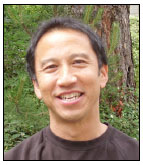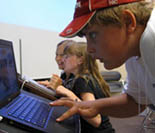Let's Face It! and CERT help autistic children
Outcome: Impact/benefit:
TDLC’s Jim Tanaka and Marni Bartlett Additional article: Marian Bartlett, Jim Tanaka, Javier Movellan, and Robert Schultz TDLC researchers are collaborating on an exciting new project intended to enhance the facial expression production abilities of children with autism. The new project integrates the computer-based intervention known as Let’s Face It! (LFI!) with UCSD’s Computer Expression Recognition Toolbox (CERT). Let’s Face It! (LFI!) is a training program designed to improve the face skills of children with autism in a variety of face processing domains. CERT is a revolutionary new software package that performs real-time expression detection via web-cam input. The integration of the LFI! program and CERT allows the child to receive immediate feedback on their facial expression productions. This technology has recently been implemented in an interactive exercise called "Smile Maze," in which users are required to produce and hold the target expression for varying lengths of time in order to navigate past obstacles located in a maze. Another new game, “Face-Face-Revolution” is modeled after the popular game Dance-Dance-Revolution, wehere the child is visually cued to produce the facial expressions of happy, angry, sad and disgusted. The motor production system may play a crucial role in the perception of visually presented facial expressions. The exercises developed by these TDLC researchers engage the production system, and may aid children with autism in learning nonverbal behaviors essential for social functioning.
Tanaka, J., Bartlett, M., Movellan, j., Littlewort, G., and Lee-Cultura, S. (2010). Face-Face-Revolution: A game in real-time facial expression recognition. Demo, Vision Sciences Society Conference, Naples, FL, May. Cockburn, J., Bartlett, M., Tanaka, J., Movellan, J., Pierce, M., and Schultz, R. (2008). SmileMaze: A Tutoring System in Real-Time Facial Expression Perception and Production for Children with Autism Spectrum Disorder. Intl Conference on Automatic Face and Gesture Recognition, Workshop on Facial and Bodily expressions for Control and Adaptation of Games.
|


